Chapter 12:
University Finances and Private Giving
Background
The University of California seeks to develop reliable sources of revenues, including a strong investment from the state, and to use these revenues in a strategic manner to sustain its tripartite mission of teaching, research and public service.
This chapter summarizes the financial challenges that the University has faced through the 2013–14 fiscal year. Revenue and expenditure data show changes in both the amounts generated (or expended) over time and their distribution across areas of activity. Trends in private support are shown.
Funding trends
Totaling about $25 billion in 2013–14, the University’s revenues fund its core mission and a wide range of support activities, including academic medical centers, the Lawrence Berkeley National Laboratory, UC Extension, and housing and dining services.
Prior to 2010–11, state funding was the largest single source of support for the education function of the University. Over the past ten years, state educational appropriations have fallen more than $1 billion in inflation-adjusted dollars despite UC’s enrollment growth. State educational appropriations constituted only 10 percent of UC’s operating budget in 2013–14 compared to 23 percent in 2001–02.
Tracking expenditures
To help mitigate declines in state funding, the University has sought to increase revenues from other sources, such as student tuition and fees, indirect cost recovery and private giving. The University also has moved aggressively to reduce operating costs. Chapter 13 identifies some of these cost savings. Even under the most optimistic assumptions, however, efficiency improvements and alternative revenue generation can offset only a portion of the budget shortfalls projected over the next few years.
What this means for students and families
Even though the actual, inflation-adjusted cost of educating a student at UC has dropped by 22 percent since 1990, the state’s share of expenditures has fallen even more steeply. As a result, students and their families must bear a growing proportion of the cost of education. Even these increases in student fees have not made up for all of the reductions in state support.
Looking forward
The November 2012 passage of Proposition 30 by California voters, combined with improvements in the California economy, promise to bring some stability to the state budget and thus to the UC budget. UC met the recent budget challenges by reducing operating costs and identifying alternative sources of revenues.
In addition, the University is making comprehensive changes in the way funds flow within the University. Historically, certain revenues have been collected centrally by the UC Office of the President and redistributed across campuses to promote systemwide priorities. Following lengthy consultation with campus leadership, beginning in 2011–12, all campus-generated funds — tuition and fees, research indirect cost recovery, and patent and investment income — have been retained by or returned to the source campus. The University has established a broad-based, flat assessment on campus funds to support the Office of the President and systemwide initiatives. The University anticipates that these changes — referred to as the Funding Streams Initiative — will simplify University financial activity, improve transparency and motivate campuses to maximize revenue.
UC will face additional financial challenges in the years to come as a result of demographic and social policy changes occurring nationwide. The population in the United States is aging and living longer. The University has adopted a series of measures designed to preserve the long-term viability of its pension and retiree health benefits while still providing attractive post-employment benefits for employees.
Similarly, as health care costs and insurance premiums continue to rise, UC will encounter mounting costs in providing subsidized health care coverage for its students, employees and retirees.
In addition, the Affordable Care Act is likely to have a profound effect on the finances of UC medical centers. Not only will there be a larger number of individuals with coverage requesting health care services, but certain reimbursements for Medicaid patients will also be reduced. These changes will affect all of American society, and UC, as a major employer and provider of health care services in the state of California, will not be exempt.
FOR MORE INFORMATION
Between 2001–02 and 2013–14, state educational appropriations decreased from 23 percent of UC revenues to 10 percent.
12.1.1 Revenues, by source, Universitywide, 2001–02 to 2013–14

Source: UC Corporate Financial System (see footnote on following page)
The steep decline in state educational appropriations as a proportion of UC’s total revenues over the past decade is a function of two trends: first, a long-term decline in state support from $4.1 billion to $2.4 billion in inflation-adjusted dollars; second, an increase in revenues from other sources, such as medical centers, contracts and grants, and student tuition and fees.
Private gift funding shown in the chart above does not include gifts to UC foundations ($897 million in 2013–14) that are reported in the foundations’ audited financial statements and not in the UC-wide statements.
12.1.2 Revenues, by source, UC campuses, 2004–05 to 2013–14
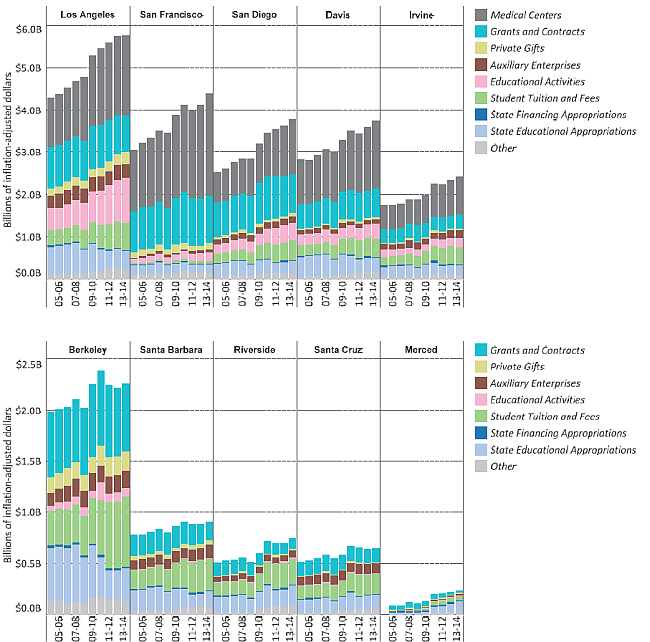
Source: UC Audited Financial Statements1
1Figures are in billions of inflation-adjusted 2013–14 dollars; Department of Energy laboratories, including the Lawrence Berkeley National Laboratory, are excluded. The Davis, Irvine, Los Angeles, San Diego and San Francisco campuses operate medical schools and teaching hospitals. In addition to the funds associated with medical school and teaching hospital operations, these programs help campuses attract additional contract and grant revenue.
Virtually all gift funds (99 percent) are restricted by donors in how they may be used.
12.2.1 Current giving, by purpose, Universitywide, 2000–01 to 2013–14
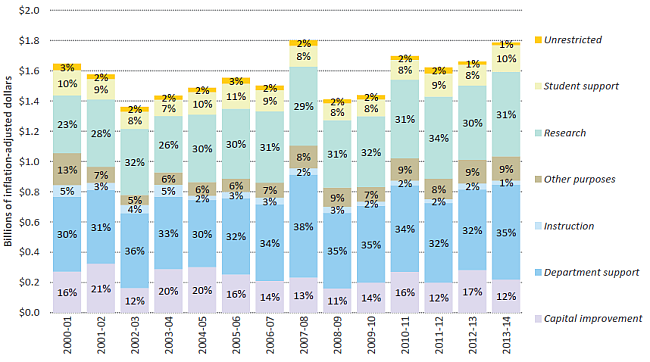
Source: UC Institutional Advancement, figures are adjusted for inflation
In 2013–14, new gifts to the University totaled more than $1.78 billion, an increase of approximately 9 percent over the prior year. Virtually all of these funds are restricted for specific purposes and are not available to support general operating costs. In addition, approximately $410 million was designated for endowment, so only the income/payout is available for expenditure.
The University is energetically pursuing increased philanthropic giving as a means to help address budget shortfalls and expand student financial aid.
A campus’s ability to raise money is related to its age, number of alumni and presence of health science programs, which attract nearly half of all private support at UC.
12.2.2 Total giving, by type, UC campuses, 2003–04 to 2013–14
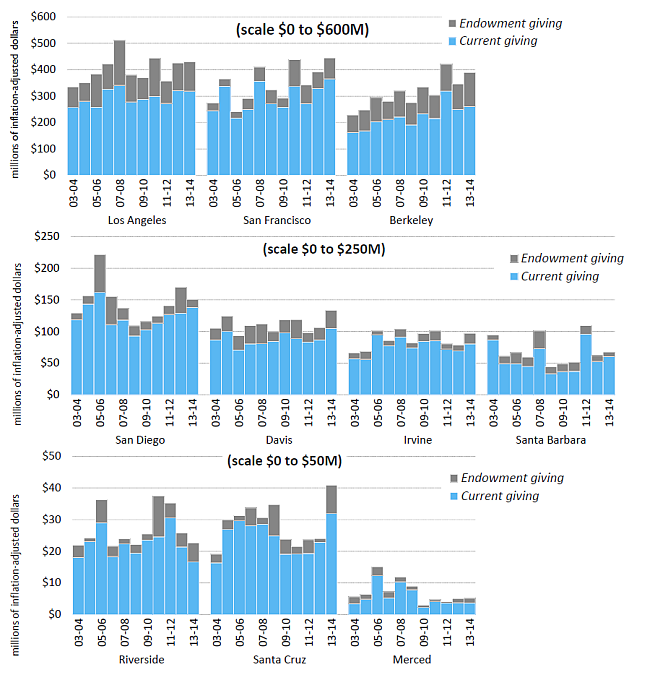
Source: Council on Aid to Education (CAE). Current giving includes all giving except for endowment giving.
The University’s share of the state’s general fund dropped from 8.1 percent in 1966–67 to 2.7 percent in 2014–15.
12.3.1 UC share of the state budget, 1966–67 to 2014–15
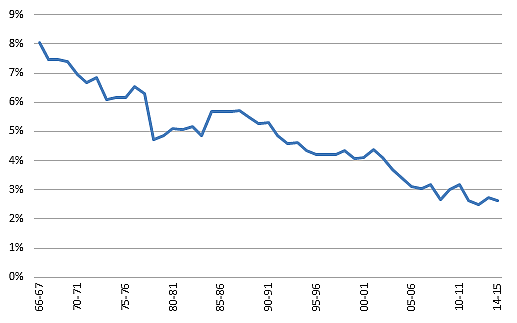
Source: UC Budget Office
Historically, state funding has been the largest single source of support for the University’s core instructional budget. Together with UC general funds and student fee revenue, state funding has provided relatively stable funding for faculty salaries and benefits, academic and administrative support, student services, facilities operation and maintenance, and student financial aid.
State support has fallen more than $1 billion in inflation-adjusted dollars since 1990–91. To compensate, the University has raised student tuition and fees, but these increases have only partially compensated for the loss of state support (indicator 12.3.2).
In addition, campuses have laid off employees, deferred faculty hiring, cut academic programs, eliminated courses, increased class size and cut back vital student services such as library hours.
Tuition and fees have risen in response to cuts in state funds.
12.3.2 Revenues and student enrollment over time, Universitywide, 1990–91 to 2014–15

Source: UC Budget Office
Since 1990–91, total student enrollment has increased by nearly 60 percent, primarily driven by the University’s continuing commitment to accommodate eligible California resident undergraduates. While state support has not kept pace, student tuition and fees have risen to partially backfill the loss of state general funds.
During the recession of the early 1990s, the University lost the equivalent of 20 percent of its state support. Later in the decade, as the economy recovered, significant funding increases were provided for enrollment growth, to avoid student fee increases and to maintain quality.
Another state fiscal crisis during the early 2000s resulted in reductions in state support during a time of rapid enrollment growth. Beginning in 2005–06, UC entered a six-year compact with the state. The state’s budget shortfalls and the onset of the most recent financial crisis led the state to renege on the compact and resulted in significant reductions in state support. For two years, no funding was provided for enrollment growth, and UC’s base budget was reduced. After partially restoring earlier cuts to UC’s budget in 2010–11, the state reduced support to UC by $750 million in 2011–12. The University received $105.9 million in new state funding in 2012–13, including $89.1 million toward the state’s share of employer contributions to the University’s retirement plan.
In 2013–14, the University received $256.5 million in new state funding for operating purposes, including $125 million for a deferred tuition and fee buy-out for 2012–13. Additional one-time funding from debt restructuring provided $85.5 million in temporary state funds that was used to cover pension costs. In 2014–15, the state provided a $142.2 million, adjustment, equivalent to 5 percent of the base budget.
Total expenditures have increased by about 50 percent in the last decade, with medical centers representing an increasing share.
12.4.1 Expenditures, by function, Universitywide, 2001–02 to 2013–14

Source: UC Audited Financial Statements1
Instruction, research and public service accounted for 38 percent of total expenditures during 2013–14.
Medical centers accounted for 28 percent of operating expenditures in 2013–14.
Libraries and other academic support services, such as instructional technology, student services, administration, and operation and maintenance of plant, accounted for 16 percent of total expenditures.
1Figures in billions of inflation-adjusted 2013–14 dollars. The Davis, Irvine, Los Angeles, San Diego and San Francisco campuses operate both medical schools and teaching hospitals. In addition to the funds associated with medical school and teaching hospital operations, the programs help campuses attract additional contract and grant revenue.
Total expenditures have increased by about 50 percent in the last decade, with medical centers representing an increasing share.
12.4.2 Expenditures, by function, UC campuses, 2004–05 to 2013–14
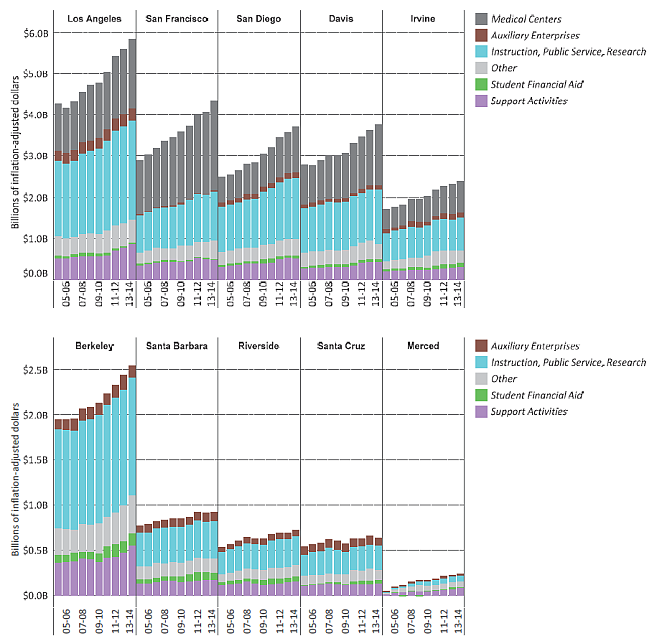
Source: UC Audited Financial Statements1
1Figures in billions of inflation-adjusted 2013–14 dollars. The Davis, Irvine, Los Angeles, San Diego and San Francisco campuses operate both medical schools and teaching hospitals. In addition to the funds associated with medical school and teaching hospital operations, the programs help campuses attract additional contract and grant revenue.
Since 1990–91, the total cost of a UC education has declined by 22 percent per student. Students and their families have borne an ever-increasing share of that cost.
12.5.1 General campus per-student average expenditures for education, Universitywide, 1990–1991 to 2014–15, selected years
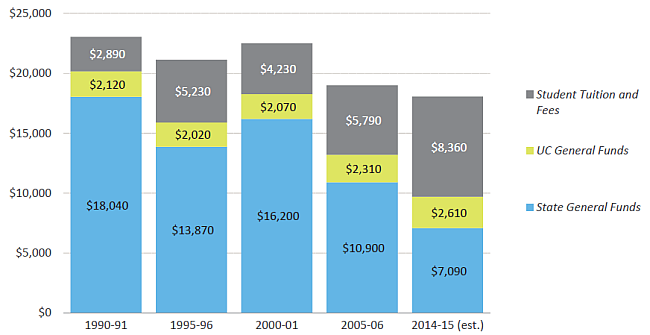
Source: UC Budget Office
Since 1990–91, average inflation-adjusted expenditures for educating UC students have declined 22 percent. During the same time period, the state’s share of expenditures has fallen even more steeply, by 61 percent. The share of expenditures borne by students in the form of fees has more than tripled, from 13 percent to 46 percent.
In other words, students and their families are bearing a growing proportion of the cost of their education. Increases in student fees have made up some (but not all) of the reductions in state support.








